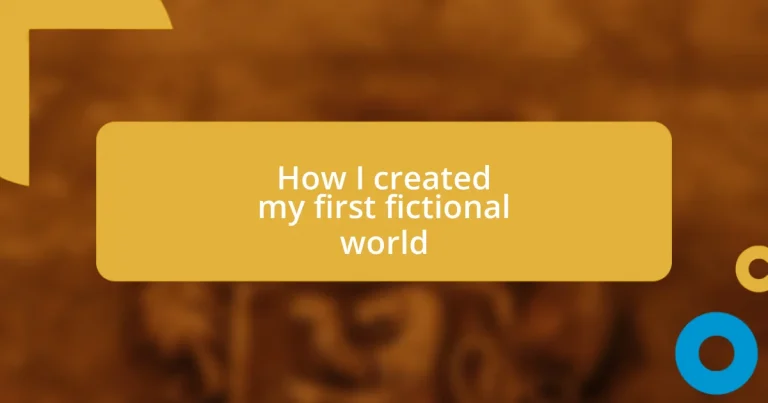Key takeaways:
- The geography of a fictional world shapes culture, conflict, and character development, with unique features like deserts and chasms influencing narratives.
- Creating authentic cultures involves outlining distinct traits such as language, rituals, and governance, allowing exploration of societal complexities and interpersonal dynamics.
- Integrating world-building into stories requires attention to how culture, geography, and history affect characters’ motivations, enhanced through immersive settings and culturally reflective dialogue.
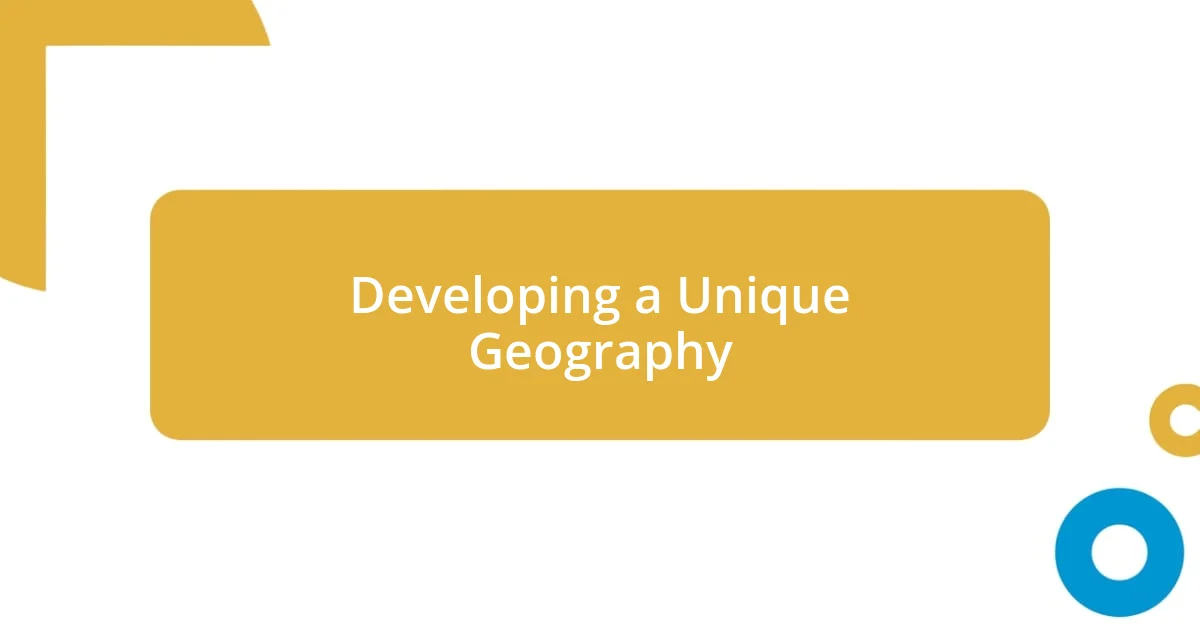
Developing a Unique Geography
When I set out to develop the geography of my fictional world, I found inspiration in the landscapes that left an impression on me during my travels. For instance, I hiked in the Rocky Mountains, where towering peaks and expansive valleys made me wonder how different climates would shape the lives of the inhabitants. How would a village nestled high in the mountains adapt to the harsh weather compared to one thriving in a lush valley?
It’s intriguing to think about how geography impacts culture and conflict. In my world, I decided to create a sprawling desert, rich with hidden oases and ancient ruins. This setting not only offers vast opportunities for exploration but also presents challenges for survival. I can almost hear the whispers of lost civilizations in the windswept sands, and it fuels my curiosity about how past inhabitants might have thrived—or failed—against such an unforgiving environment.
One of my favorite aspects of geography is the potential for unique geographical features that can drive plot and character development. I tucked a giant chasm, known as the Rift of Echoes, into my world. Imagine standing at its edge, the air heavy with the scent of minerals while echoes of the past reverberate through the depths. It became a pivotal location in my story, a haunting reminder that geography isn’t just a backdrop; it’s an integral part of the narrative that shapes the destinies of my characters.
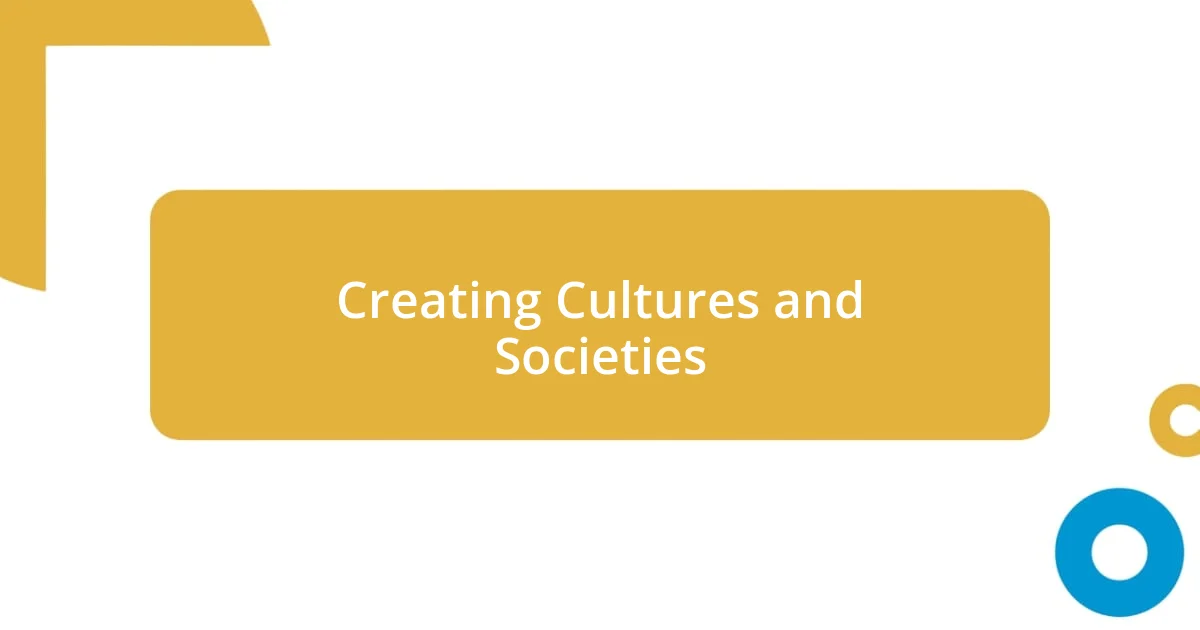
Creating Cultures and Societies
Creating cultures and societies in my fictional world was a journey of discovery, reflecting my fascination with human behavior and community. I based many cultural norms on real traditions and societal structures I’ve encountered in my life. For example, drawing from my experiences in diverse neighborhoods, I imagined a society where communal meals are a sacred ritual, signifying unity and shared history. This idea wasn’t just an aesthetic choice; it allowed me to explore themes of connection and conflict through characters who had differing views on communal living.
As I fleshed out the cultures of my world, I found it helpful to outline specific cultural traits:
- Language: Each society has its own dialect that reflects its values and priorities.
- Rituals: Unique ceremonies mark significant life events, influencing relationships and social hierarchies.
- Art and Expression: The style of art tells stories of their past struggles, victories, and community ethos.
- Beliefs and Myths: Different societies hold distinct beliefs that shape their worldview and moral compass.
- Governance: Each culture has its own system of leadership, either democratic, authoritarian, or tribal, influencing how decisions are made.
With each trait I created, I felt the weight of responsibility to portray them accurately, aiming not just to craft a narrative but to honor the complexities of culture itself. This part of world-building truly enriched my story, as I engaged with the intricacies of each society’s beliefs, values, and interpersonal dynamics.
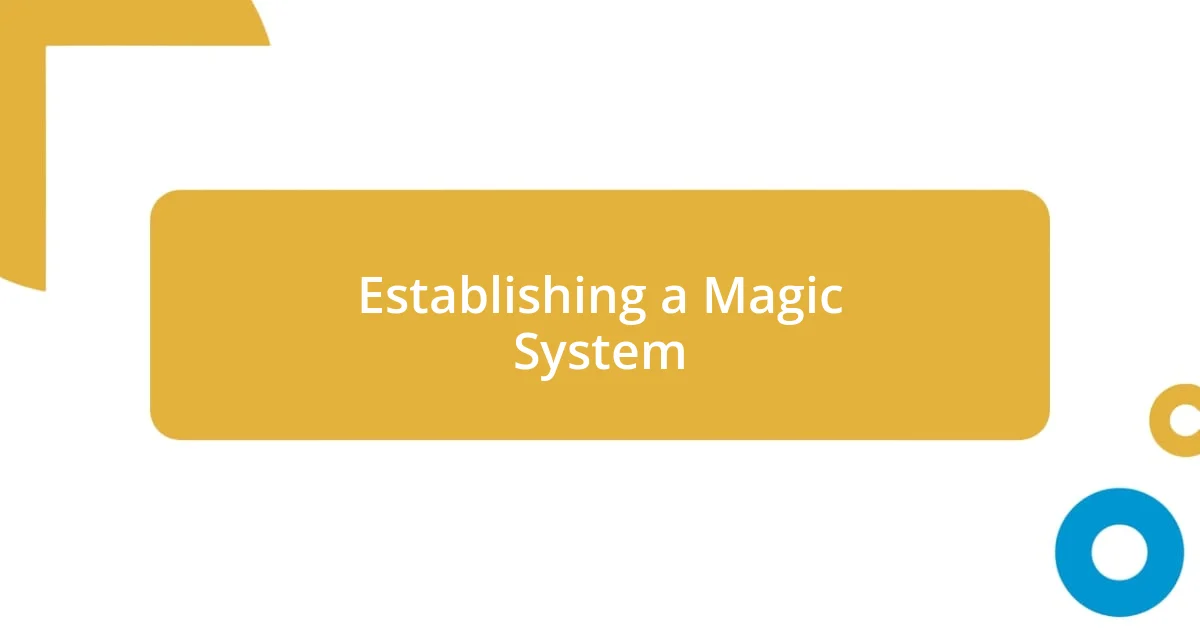
Establishing a Magic System
Establishing a magic system is one of the most exhilarating aspects of world-building, as it lays down the rules of the fantastical elements that will drive my story. Drawing from my experiences with various mythologies, I chose to create a structured system where magic isn’t just an arbitrary force; it’s rooted in the natural world. I remember being captivated by the idea that magic could intertwine with elements like the moon, earth, or even emotions, making the use of it a reflective practice that shows the characters’ inner struggles and growth.
I vividly recall the moment I crafted the concept of “Emotion Weaving.” It was an uplifting yet humbling experience, learning that magic could stem from the characters’ emotional states. For instance, a character filled with rage could unleash destructive force, while one rooted in love might create beautiful illusions. This insight led me to explore how magic influences relationships and conflicts within the narrative. By harnessing the power of feelings, I crafted a depth that mirrors real-life challenges, inviting readers to connect with the characters on an emotional level.
To further clarify my magic system, I found it beneficial to establish clear limitations and costs to magical practices. After all, if everything were possible, wouldn’t that take away the tension and stakes? I decided that every use of magic would require a price, whether it be physical exhaustion or emotional toll, keeping the characters grounded and relatable, and ensuring that the stakes always remained high.
| Magic System Element | Description |
|---|---|
| Source of Magic | Derived from natural elements and emotional states. |
| Usage Cost | Exerts physical exhaustion or emotional strain on the user. |
| Impact on Relationships | Influences dynamics between characters, often mirroring inner struggles. |
| Limitations | Specific circumstances dictate when and how magic can be used. |
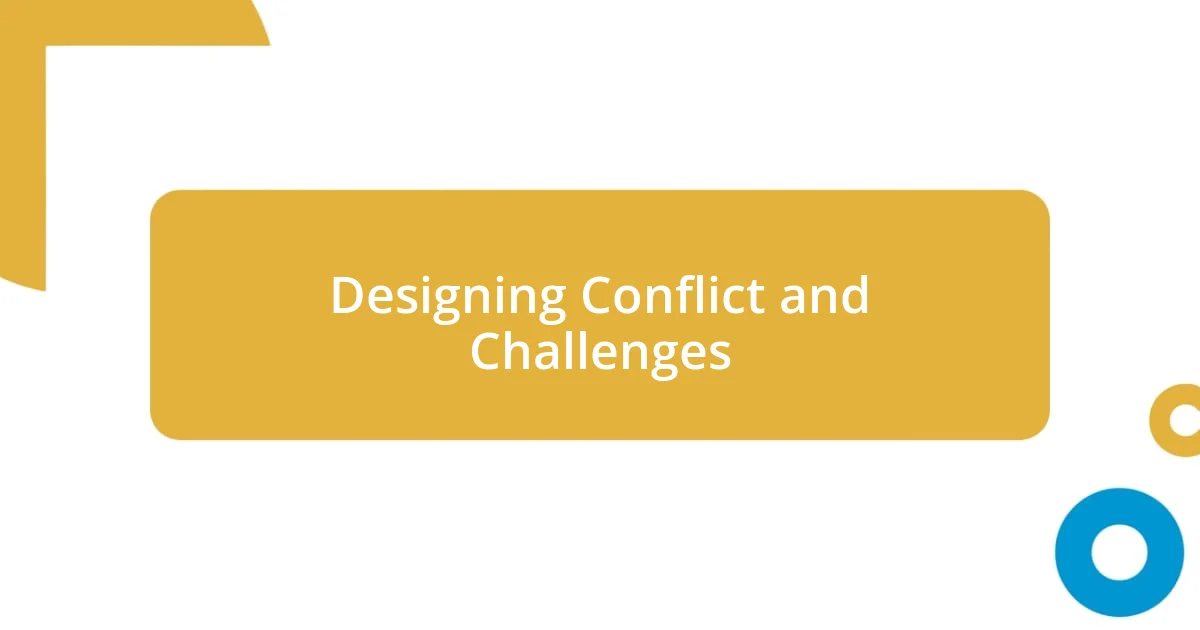
Designing Conflict and Challenges
When designing conflict and challenges in my fictional world, I often draw from my own experiences with adversity. I remember a time when I faced a tough decision that felt like a crossroads in my life. That sense of tension and uncertainty is precisely what I wanted to mimic in my characters’ journeys. If they are not challenged, can they truly grow? I firmly believe that placing characters in situations that test their values and push their limits creates not only compelling narratives but also relatable journeys for the readers.
Conflicts should be diverse and multilayered, just like real life. For example, I woven in both interpersonal disputes and larger societal conflicts. One character may struggle with betrayal from a trusted friend, while another grapples with a societal expectation that goes against their core beliefs. This duality allows me to explore how different types of conflict influence each other. I’ve always found that the way characters deal with internal and external challenges reveals their depth—don’t you find it fascinating to see how relatability can emerge from the most challenging circumstances?
Additionally, I realized that challenges often arise from misunderstandings or differing perspectives. I once participated in a project where team members held incompatible viewpoints, leading to standout moments of tension and innovation. Drawing from that experience, I created scenarios where misunderstandings spark conflict among my characters. This approach naturally leads to growth, allowing them to evolve as they navigate their way through the chaos. After all, who hasn’t encountered a rocky road that ultimately paved the way for deeper connections?
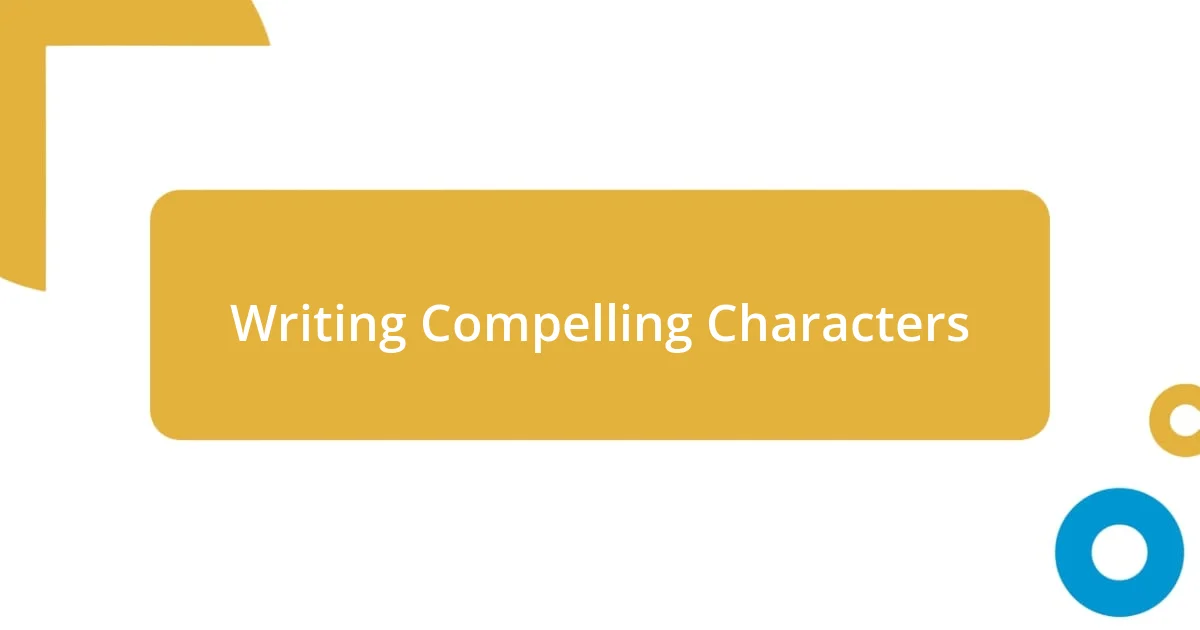
Writing Compelling Characters
Creating compelling characters is like sculpting a piece of art; it requires an understanding of shapes, shadows, and depth. I often start with a single, vivid trait that encapsulates their essence—maybe it’s a fierce loyalty or an overwhelming fear of abandonment. I remember the thrill of developing a character whose strength turned into a flaw; her unwavering determination sometimes blinded her to the needs of those around her, making her both admirable and deeply relatable. It’s this duality that keeps the reader invested.
I’ve found that the backstory is essential to developing rich, three-dimensional characters. It’s not just about where they come from, but how their past shapes their decisions and relationships in the present. For instance, I once crafted a character with a troubled childhood—she learned to fend for herself but also built walls against vulnerability. When she finally opens up to another character, it’s powerful, isn’t it? It brings tears to my eyes because it reflects our own struggles with trust and intimacy. This kind of depth invites readers to root for my characters, as they see pieces of themselves in them.
Emotional stakes are another critical component. I always ask myself: “What does this character stand to lose?” When I fashioned a protagonist who absolutely has to save her dying sibling, the urgency pushed her into scenarios that forced her to confront her fears. It becomes a journey not just of physical survival but of emotional evolution. Readers become invested in the outcome because they can feel the weight of that loss; they recognize the fierce desire to protect loved ones, sparking empathy and engagement, don’t you think? Each character should carry their unique burdens, creating a tapestry of struggles that resonate with readers on multiple levels.
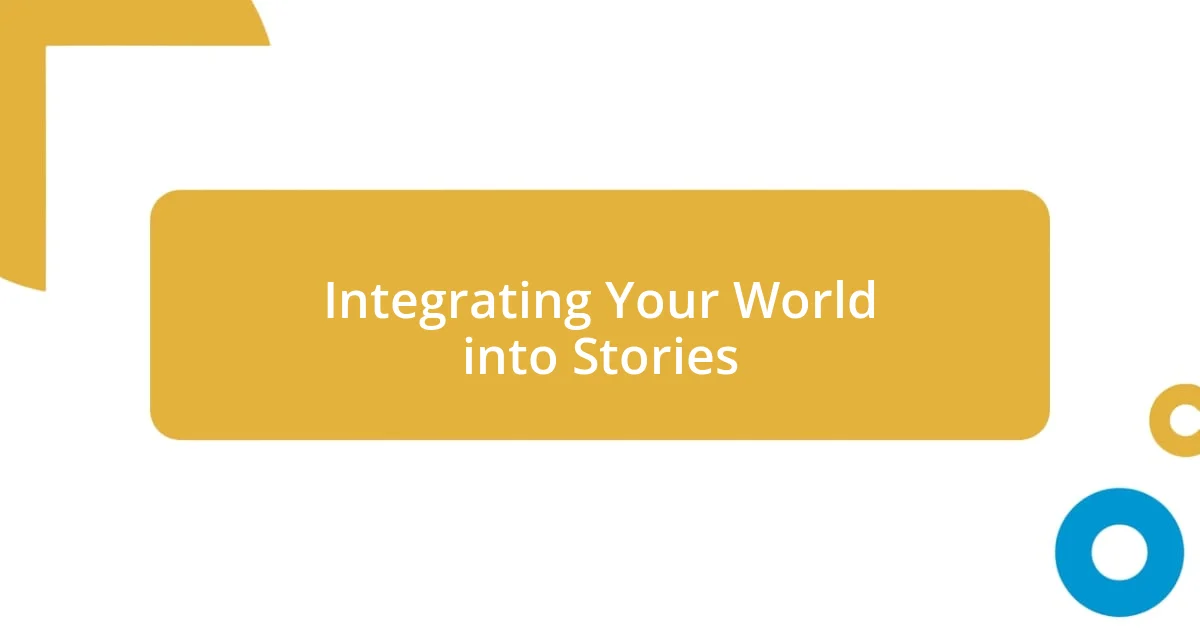
Integrating Your World into Stories
Integrating the world I created into the stories I write feels like painting a dynamic landscape, where every detail adds depth to the narrative. I always keep in mind how the world’s culture, geography, and history influence my characters’ motivations and choices. For instance, I remember a time when I crafted a city that thrived on trade, making my characters’ ambitions and conflicts revolve around the opportunities and pitfalls of commerce. How does the setting shape your characters’ actions? It’s a question I constantly reflect on as I weave my world into the fabric of the story.
Bringing my world to life means ensuring that it feels as real and immersive as the characters inhabiting it. I once set a pivotal scene during a festival in my fictional realm, where vibrant traditions clashed with underlying tensions among various factions. The energy of the festival highlighted the characters’ personal stakes, revealing their desires and fears in contrast to the celebrations around them. Have you ever noticed how a setting can amplify emotional moments? That’s what I aim for—using the world to enrich the experience for readers.
Additionally, I’ve learned that dialogue can be a powerful tool for integrating my world into the narrative. For example, crafting conversations that reflect its unique dialect, proverbs, or even challenges allows readers to experience the world first-hand. I drew from a situation where I encountered different cultural expressions in my travels. It’s incredible how language can infuse characters with life and personality. When my characters exchange banter embedded with cultural references, it not only adds authenticity but also invites readers to explore the nuances of that world alongside them. How do you use dialogue to deepen your own story worlds? It’s worth contemplating!












